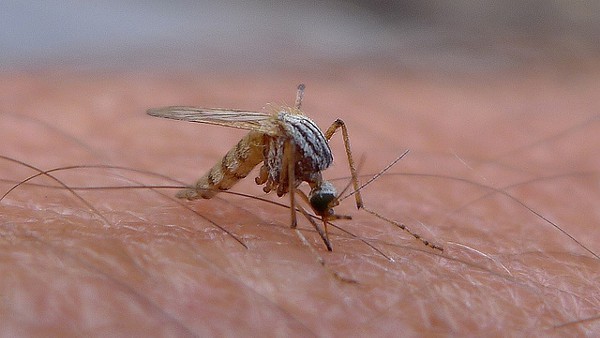“Cardio”exercise linked to much lower risk of flu or pneumonia death ...
What We Know About The Malaria Case In South Texas

Flickr Creative Commons
The current malaria outbreak is the first in the U.S. Since 2003, according to the CDC.
This week, the reporting of four malaria cases in Florida and one in Texas grabbed headlines as a disease thought eradicated decades ago in the U.S. Made a surprise return.Even though the single Lone Star State case was reported in the South Texas, infectious disease expert Dr. Bonnie M. Word — director of the Houston Travel Medicine Clinic — told the Current there's no reason to worry.
"Sometimes, this is just a plane ride away from coming in," Word said. "In this case, we've been fortunate enough that we haven't identified another case in Texas. But it's been four already in Florida."
Here's everything South Texans need to know about the malaria cases.
Why is malaria in Texas?The most recent malaria cases are the first reported in the U.S. Since 2003, causing the Centers for Disease Control along with health departments in Texas and Florida to issue public health alerts.
Indeed, the CDC considered malaria to be eradicated here in 1951, according to the agency's website. The elimination of the tropical disease, which up until that point, was a severe problem in the U.S. South, was in large part due to the development of insecticides, bug sprays, drainage ditches and window screens, as reported by NPR.
Although malaria is no longer a major threat stateside, Word said occasional outbreaks occur, brought on by travelers to the U.S. From places that still struggle to contain the disease.
"Travel has picked up in the last year or two, and they're going to destinations where not only malaria is present but other diseases that are transmitted by mosquitoes," she added.
According to Word, the current malaria cases likely didn't originate in the U.S. Instead, a person probably came from back from travel abroad while unknowingly infected. Once stateside, the victim was bit by a local mosquito, which then went on to bite another resident. This is called "local transmission."
Is malaria deadly?Although malaria is serious, the strain circulating in Texas and Florida, known as vivax malaria, is highly treatable, according to Word.
"Most people — a majority of people — survive," she said. "Death is not very common at all, and rarely is there any organ damage."
The problem for the CDC, though, is that victims of vivax malaria may not even know they're infected for months.
According to Word, the vivax parasite can hide in the liver of victims for three months before they begin to exhibit symptoms — usually a fever, followed by chronic fatigue, nausea and diarrhea. Even though the patient isn't showing signs, they can still unknowingly spread the disease if bitten by an uninfected mosquito.
On average, vivax malaria takes about two weeks to incubate.
How do I stay safe?Although the recent malaria cases garnered media and CDC attention, Word said Texans should feel safe. Even so, there are precautions they can take.
"Around your home, you'll want to get rid of any free-standing water, like bird baths or those little blowup pools outside that [children swim in]," Word said.
Word also encouraged residents to use bug spray and wear long pants. For those who don't like the feeling of bug spray on their skin, she recommended misting clothes with permethrin, an EPA-approved bug repellent that can be applied to clothes and won't come off in the wash for several cycles.
Subscribe to SA Current newsletters.
Follow us: Apple NewsGoogle NewsNewsBreakRedditInstagramFacebookTwitterOr sign up for our RSS Feed
Researchers Discover How An Infectious Parasite Uses Immune Cells As A Trojan Horse
University of Calgary researchers have discovered how Leishmania parasites hide within the body to cause Leishmaniasis. The tiny parasites are carried by infected sand flies. Considered a tropical disease, 1 to 2 million people in more than 90 countries are infected every year. Effects range from disfiguring skin ulcers to enlarged spleen and liver and even death.
This chronic disease has been difficult to detect in the early stages. Scientists realized that the parasite was somehow manipulating immune cells but this process had not been well understood.
"This is the first study that shows how the parasite stalls the process of regular neutrophil cell death which prevents the immune system from being activated," says Dr. Nathan Peters, Ph.D., associate professor, at the Cumming School of Medicine (CSM) and principal investigator. The study is published in The Journal of Immunology.
Neutrophils are a type of white blood cell which are the body's first line of defense against infection and disease. Researchers in the Peters lab found that the parasite targets a receptor on the surface of the neutrophil to gain access inside the cell. Once there the parasite resists the neutrophils' pathogen-killing molecules.
"The neutrophil then acts like a little Trojan Horse," says Peters. "The parasite finds a niche inside these neutrophils and makes the neutrophil look like it is a regular dying cell, a process that happens constantly and therefore doesn't activate the immune system."
The parasite stalls the process of cell death in the neutrophil, enabling the parasite to persist inside the immune cell and establish infection. Experimental vaccines aimed at preventing the infection haven't been effective.
"The parasite's behavior interferes with our ability to vaccinate, because the immune system isn't even aware that the parasite is there," Peters says.
This research, conducted in mice, took place in a highly specialized laboratory, called the Insectary. This space within the Peters' lab enables researchers to raise sand flies infected with the Leishmania parasite.
"Understanding the earliest interactions between the parasite and the host helps explain why previous vaccination strategies against Leishmaniasis have been unsuccessful," says Adam Ranson, first author. "Our findings will contribute to bringing researchers closer to developing an effective vaccine against Leishmania infection."
More information: Adam J. Ranson et al, C3/CD11b-Mediated Leishmania major Internalization by Neutrophils Induces Intraphagosomal NOX2-Mediated Respiratory Burst but Fails to Eliminate Parasites and Induces a State of Stalled Apoptosis, The Journal of Immunology (2023). DOI: 10.4049/jimmunol.2200720
Citation: Researchers discover how an infectious parasite uses immune cells as a Trojan Horse (2023, June 26) retrieved 30 June 2023 from https://medicalxpress.Com/news/2023-06-infectious-parasite-immune-cells-trojan.Html
This document is subject to copyright. Apart from any fair dealing for the purpose of private study or research, no part may be reproduced without the written permission. The content is provided for information purposes only.
UCalgary Researchers Discover How Leishmania Parasites Hide Within The Body
University of Calgary researchers have discovered how Leishmania parasites hide within the body to cause Leishmaniasis. The tiny parasites are carried by infected sand flies. Considered a tropical disease, one to two million people in more than 90 countries are infected every year. Effects range from disfiguring skin ulcers to enlarged spleen and liver and even death.
This chronic disease has been difficult to detect in the early stages. Scientists realized that the parasite was somehow manipulating immune cells but this process had not been well understood.
This is the first study that shows how the parasite stalls the process of regular neutrophil cell death which prevents the immune system from being activated."
Dr. Nathan Peters, PhD, associate professor, at the Cumming School of Medicine (CSM) and principal investigator
Neutrophils are a type of white blood cell which are the body's first line of defense against infection and disease. Researchers in the Peters lab found that the parasite targets a receptor on the surface of the neutrophil to gain access inside the cell. Once there the parasite resists the neutrophils' pathogen-killing molecules.
"The neutrophil then acts like a little Trojan Horse," says Peters. "The parasite finds a niche inside these neutrophils and makes the neutrophil look like it is a regular dying cell, a process that happens constantly and therefore doesn't activate the immune system".
The parasite stalls the process of cell death in the neutrophil, enabling the parasite to persist inside the immune cell and establish infection. Experimental vaccines aimed at preventing the infection haven't been effective.
"The parasite's behavior interferes with our ability to vaccinate, because the immune system isn't even aware that the parasite is there," Peters says.
This research, conducted in mice, took place in a highly specialized laboratory, called the Insectary. This space within the Peters' lab enables researchers to raise sand flies infected with the Leishmania parasite.
"Understanding the earliest interactions between the parasite and the host helps explain why previous vaccination strategies against Leishmaniasis have been unsuccessful," says Adam Ranson, first author. "Our findings will contribute to bringing researchers closer to developing an effective vaccine against Leishmania infection."
The study was highlighted as a 'Top Read' in The Journal of Immunology.
Source:
Journal reference:
Ranson, A. J., et al. (2023) C3/CD11b-Mediated Leishmania major Internalization by Neutrophils Induces Intraphagosomal NOX2-Mediated Respiratory Burst but Fails to Eliminate Parasites and Induces a State of Stalled Apoptosis. The Journal of Immunology. Doi.Org/10.4049/jimmunol.2200720.



Comments
Post a Comment